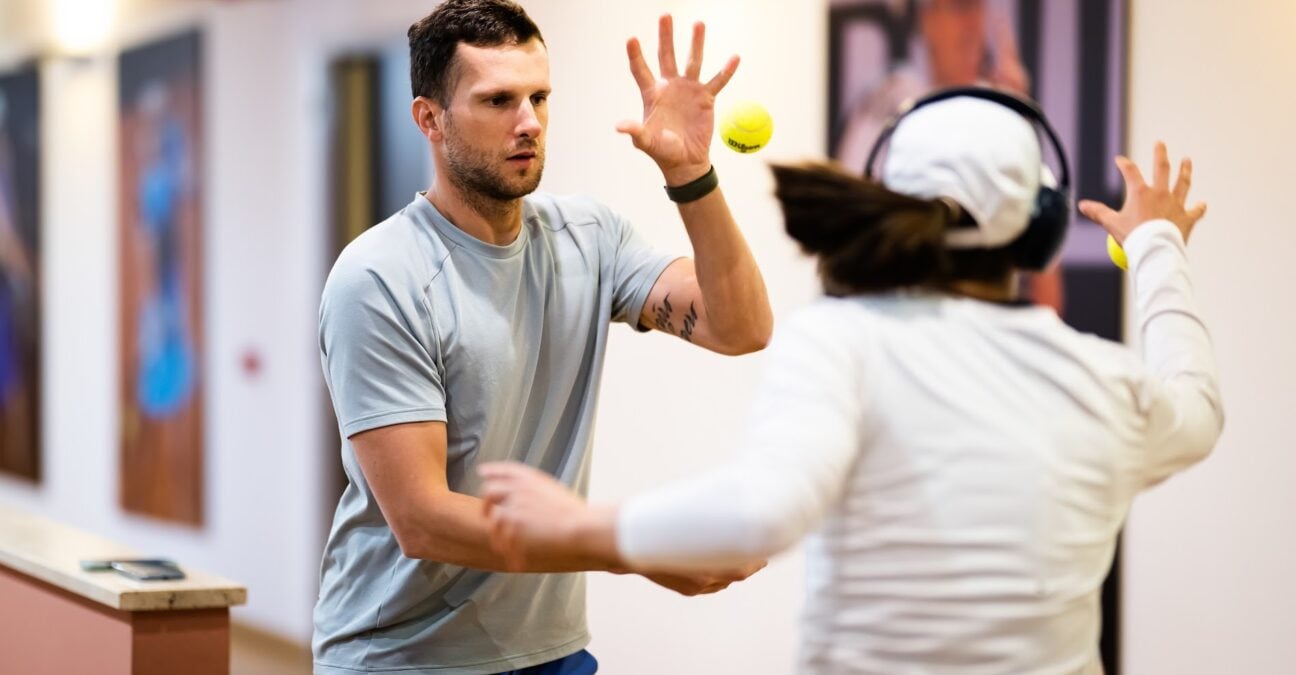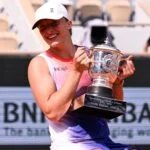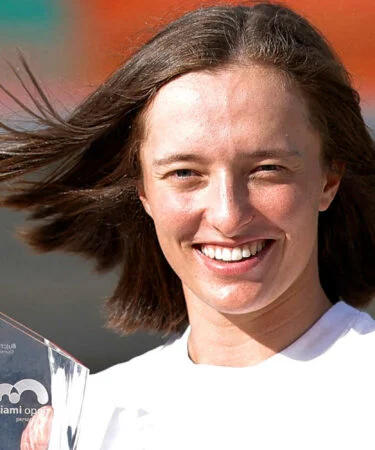“We didn’t know how she was going to react”: Ryszczuk built Swiatek’s body to support her mind
Maciej Ryszczuk has been working on turning Iga Swiatek into a top athlete for the past four years. He told us how it paid off through that clay season.
 Maciej Ryszczuk, Iga Swiatek’s physiotherapist, strength and conditioning coach (Zuma / Panoramic)
Maciej Ryszczuk, Iga Swiatek’s physiotherapist, strength and conditioning coach (Zuma / Panoramic)
It’s not an easy job to be responsible for the World No 1 and Roland-Garros queen’s body’s abilities. Maciej Ryszczuk was all smiles and relief when we caught up with him not even an hour after Iga Swiatek’s fourth title at Roland-Garros.
In a tennis world where there’s always more work to be done, the physiotherapist, who is also a strength and conditioning coach, could at least enjoy the team’s success for a few hours before having to turn his brain to the grass season.
Last year, Swiatek got a thigh injury in Rome, and in Ryszczuk’s words, “It was risky even if it ended well.” But this year might still be the clay season that surprised him the most because everything was set for some tough challenges, and yet Swiatek got through.
“To be honest, this year, we didn’t know how she was going to react. She played a lot of tournaments in a row, so I wasn’t so sure. All my data said it should be fine.
“We were thinking that if she could handle it mentally… Because it’s the same routine for 10 weeks: it’s a lot, and it can get boring… But if she could accept, mentally, to push, then we knew her body was supposed to handle it, too.”
And it did. Swiatek has repeatedly praised Ryszczuk’s work and influence in her rise to the top of the game. The Pole is amongst the least injured players on Tour and showed quite the recovery skills and strength this year by going through the BJK Cup, Stuttgart, Madrid, Rome, and Roland-Garros. The funny thing for Ryszczuk is that it wasn’t a done deal four years ago when he started to work with her.
“It was chaos everywhere”
“In the beginning, it wasn’t so hard to think about the plan because she was dynamic, powerful, but there was a lot of chaos. It was chaos everywhere: she was everywhere with her movement, with her shots, and so on.
“I knew we had to put everything in frames and then work step by step to show her she could build slowly and put everything together. She likes Lego, so she was like Lego: it was a lot of great pieces, but we needed to put them together.
“When we started working together, it was Covid time so we had a little bit more time to build the base. Of course, she has good genetics, but it’s still a lot of work. We pushed her, and I told her when we started that she could be tired during the tournaments, but it’s fine because we’re going to build through that year for the future. We’re not in the short-term, it’s not a sprint, it’s really a long-term view.”
To make sure the pieces of the puzzle would stay glued to each other until the victory at the French Open, Ryszczuk and the team got Swiatek through a rough training block in Warsaw after Miami.
“The main training we did between changing surfaces when we had a little bit more time. We had a block of training with a lot of endurance and strength training, the same as the pre-season.”
Yet he knows when too much is too much. He’d throw some funnier routines in, like playing football or some frisbee. And he’ll cut what needs to be cut: “When she was tired in Warsaw because we had this intense block, I told the team we’d have a short practice in the morning but cancel the other practice and go to karting. It was fun and refreshing.”
Still, it was the exception because Swiatek wouldn’t want it in any other way: “She loves her routine. She doesn’t like to have to do different things, only from time to time.”
“She likes to argue with us”
This very long and demanding clay season kind of broke their routine, though, and had Ryszczuk taking a gamble.
“She has been fatigued many times, but my main goal is to monitor everything. With the coach, we need to decide when to push, when to stop, if there is a time to stop. This year, it was really good but also intense, so it was the first time that we gave her free days during a tournament between matches because we didn’t have any other option. It was the best option for me. After four years with her, I knew it would be good; it would fulfill her energy and give her time to recover.”
So in Madrid, for example, Swiatek found herself enjoying strolling in the park and going shopping instead of training. And it worked.
Asked if it was also due to some injury prevention work they might be doing, Ryszczuk explained that, actually, he doesn’t really buy the whole injury prevention concept. Yet, Swiatek is barely injured all season long? Yes, but it’s because he builds her body to be able to handle the pain.
“The funny thing is that normally, there’s no such thing as injury prevention in my way of thinking. If you don’t want to get injured, then just lay on your couch. If we build the strength capacity of the tissues, then the risk of injury is much lower. So, we are lowering her risk of injury by building her strength in different ranges of motions, in her capacity, tissue strength, and endurance. After this, she can recover faster, and then she should be more used to the fatigue she has experienced during the tournaments.”
“there’s no such thing as injury prevention “
Iga Swiatek might only be 23 and surrounded by a very experienced team, but there’s no doubt that she’s the boss. The ever-discrete and introverted star, she nonetheless demands to understand everything the team asks her to do. Ryszczuk laughs about it.
“She likes to argue with us. When I tell her it’s time to stop, she will say she wants to do a little bit more, and if I say we need to do more, she’ll say, maybe it’s time to stop! It’s not as easy with her as everyone might think!”
Like every champion, Swiatek is a perfectionist, which also explains her need to understand everything. It also explains the very thin margin for error that she tolerates.
“She’s a perfectionist, so if there’s any mistake or some struggles in the movement, it’s then crucial to work on it, to talk with her, to explain to her why we’re doing this and when we’re going to improve this. She likes to see a lot of data but only one time, and then she doesn’t want to listen to it.”
“Not many people know about it, but it’s a big pressure”
Yet, she’s also expressed many times how she needed to rely on her team for the many things she didn’t feel she could handle on her own. To focus on winning, Swiatek learns to delegate. Ryszczuk doesn’t deny that there is a lot of pressure.
“Yes, for sure. Not many people know about it, but it’s a big pressure. I feel the pressure. She’s not the one putting a lot of pressure because she trusts me, but at the beginning, she was asking a lot of questions. Once we gained the trust, we could easily go from year to year and tournament to tournament.
“But it’s a lot of pressure because you can’t make mistakes. If with the coach you give her a day off but then she’s out of her tennis, it’s going to be our fault. If we push too much and then she gets injured, then again it’s our fault. There’s a lot of pressure, but for now, it’s fine.”
It’s also stress-inducing when the goal is to win Roland-Garros every year. We tend to talk a lot about the need to peak at the right time, but Ryszczuk doesn’t believe in that.
“Indeed, I don’t like this word. In tennis, I think it’s almost impossible because players would be dead tired in a lot of tournaments as, to peak, you need to push a little more, then a little bit more, then even more, but there is no time for this during the season.
“So, I prefer to stay at 80 or 90 percent of her maximum abilities all season, monitor her fatigue, and build through the year.”
“her physical ability is the foundation “
What’s interesting in the way Swiatek developed as a player is that you can see how getting stronger physically helped her mentally. She’s the emotional type, she needs to have reassuring anchors when things get overwhelming. The mental work done is one thing, the tennis skills are another, but the building of a strong body really blends it all together.
“I think her physical ability is the foundation,” said Ryszczuk. “When she is under pressure, under stress, it’s the main thing she can count on. When you are strong physically, you can always rely on it. It’s one of the main reasons she can handle the pressure, added to the mental and technical work. You can be strong mentally, but if you don’t have the physical condition, It’s not gonna help you.”
The crazy thing in tennis at this level is also that the race to get better never stops. It’s ingrained in the players’s brains that they always need to get better and that there’s a better version of themselves waiting for them. Iga Swiatek might have won her fifth Grand Slam title in Paris, but there are already talks of how she could finally find the key to the grass season.
The quest for the margin of improvement never stops. Yet, with quite a refreshing approach, Ryszczuk thinks that sometimes it actually should.
“Yes, there’s still a lot to improve with Iga, but there’s also the need to see that there is no need to crush it. More strength is maybe not necessary. I want her faster, with more power, but if we build more strength, it may not improve her tennis. I need to be careful.
“The main goal is to stay at this intensity with the same consistency. It’s maybe less about improving than about staying at the same level year after year.”
When the sky is the limit, but you already stand at the top of the mountain, it’s fine to breathe a bit, indeed.
















